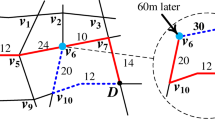Abstract
In order to describe the characteristics of dynamic traffic flow and improve the robustness of its multiple applications, a dynamic traffic temporal-spatial model (DTTS) is established. With consideration of the temporal correlation, spatial correlation and historical correlation, a basic DTTS model is built. And a three-stage approach is put forward for the simplification and calibration of the basic DTTS model. Through critical sections pre-selection and critical time pre-selection, the first stage reduces the variable number of the basic DTTS model. In the second stage, variable coefficient calibration is implemented based on basic model simplification and stepwise regression analysis. Aimed at dynamic noise estimation, the characteristics of noise are summarized and an extreme learning machine is presented in the third stage. A case study based on a real-world road network in Beijing, China, is carried out to test the efficiency and applicability of proposed DTTS model and the three-stage approach.
Similar content being viewed by others
References
FRANKEL F, REID R. Big data: Distilling meaning from data [J]. Nature, 2008, 455(7209): 30.
LOS W, WOOD J. Dealing with data: Upgrading infrastructure [J]. Science, 2011, 331(6024): 1515–1516.
ZHANG Yong, LI Shi-gao. Analysis of scale-free characteristic on sharp variation point of trafficc flow [J]. Acta Physica Sinica, 2014, 63(24): 240509. (in Chinese)
CHANG Gang, ZHANG Yi, YAO Dan-ya. Missing data imputation for traffic flow based on improved local least squares [J]. Tsinghua Science and Technology, 2012, 17(3): 304–309.
DONG Shen, LI Rui-min, SUN Li-guang, CHANG T H, LU Hua-pu. Short-term traffic forecast system of Beijing [J]. Transportation Research Record, 2010(2193): 116–123.
XU Cheng-cheng, LIU Pan, WANG Wei, LI Zhi-bin. Evaluation of the impacts of traffic states on crash risks on freeways [J]. Accident Analysis and Prevention, 2012, 47: 162–171.
TAN Hua-chun, WU Yuan-kai, CHENG Bin, WANG Wu-hong, RAN Bin. Robust missing traffic flow imputation considering nonnegativity and road capacity [J]. Mathematical Problems in Engineering, 2014, 2014: 763469.
XU Dong-wei, DONG Hong-hui, LI Hai-jian, JIA Li-min, FENG Yuan-jing. The estimation of road traffic states based on compressive sensing [J]. Transportmetrica B: Transport Dynamics, 2015, 3(2): 131–152.
WANG Jin, SHI Qi-xin. Short-term traffic speed forecasting hybrid model based on chaos-wavelet analysis-support vector machine theory [J]. Transportation Research Part C, 2013, 27(S1): 219–232.
CHENG Rong-jun, HAN Xiang-lin, LO Siu-ming, GE Hong-xia. A control method applied to mixed traffic flow for the coupled-map car-following model [J]. Chinese Physics B, 2014, 23(3): 030507.
LIANG Zi-lu, WAKAHARA Y. Real-time urban traffic amount prediction models for dynamic route guidance systems [J]. EURASIP Journal on Wireless Communications and Networking, 2014, 2014: 85.
SHENG Peng, WANG Jun-feng, TANG Tie-qiao, ZHAO Shu-long. Long-range correlation analysis of urban traffic data [J]. Chinese Physics B, 2010, 19(8): 080205.
CHEN Xi-qun, LI Li, LI Zhi-heng. Phase diagram analysis based on a temporal-spatial queueing model [J]. IEEE Transactions on Intelligent Transportation System, 2012, 13(4): 1705–1716.
CHEN Shao-kuan, WEI Wei, MAO Bao-hua, GUAN Wei. Analysis on urban traffic status based on improved spatio-temporal Moran’s I [J]. Acta Physica Sinica, 2013, 62(14): 148901. (in Chinese)
PAN T L, SUMALEE A, ZHONG R X, INDRA-PAYOONG N. Short-term traffic state prediction based on temporal-spatial correlation [J]. IEEE Transactions on Intelligent Transportation System, 2012, 14(3): 1242–1254.
WU Shan-hua, YANG Zhong-zhen, ZHU Xiao-cong, YU Bin. Improved k-nn for short-term traffic forecasting using temporal and spatial information [J]. Journal of Transportation Engineering, 2014, 140(7): 04014026.
LU Hua-pu, SUN Zhi-yuan, QU Wen-cong. Big data-driven based real-time traffic flow state identification and prediction [J]. Discrete Dynamics in Nature and Society, 2015, 2015: 284906.
PENG Yu, LEI Miao, LI Jun-bao, PENG Xi-yuan. A novel hybridization of echo state networks and multiplicative seasonal ARIMA model for mobile communication traffic series forecasting [J]. Neural Computing & Application, 2014, 24(3/4): 883–890.
ZHENG Zu-duo, SU Dong-cai. Short-term traffic volume forecasting: A k-nearest neighbor approach enhanced by constrained linearly sewing principle component algorithm [J]. Transportation Research Part C, 2014, 43(S1): 143–157.
ZHANG Ru-hua, YANG Xiao-guang, CHU Hao. Application of signal sampling theory on traffic flow detector layout [J]. China Journal of Highway Transport, 2007, 20(6): 105–110. (in Chinese)
GUYON I, ELISSEEFF A. An introduction to variable and feature selection [J]. Journal of Machine Learning Research, 2003, 3(7/8): 1157–1182.
XIA Ying, LIANG Zhong-jun, WANG Guo-yin. Research of shortterm traffic flow forecasting model based on spatio-temporal analysis [J]. Journal of Nanjing University: Natural Sciences, 2010, 46(5): 552–560. (in Chinese)
DONG Hong-hui, SUN Xiao-liang, JIA Li-min, LI Hai-jian, QIN Yong. Traffic condition estimation with pre-selection space time model [J]. Journal of Central South University, 2012, 19(1): 206–212.
LU Hua-pu, SUN Zhi-yuan, QU Wen-cong, WANG Ling. Real-time corrected traffic correlation model for traffic flow forecasting [J]. Mathematical Problems in Engineering, 2015, 2015: 348036.
ALEXANDRE E, CUADRA L, SALCEDO-SANZ S, PASTORSANCHEZ A, CASANOVA-MATEO C. Hybridizing extreme learning machines and genetic algorithms to select acoustic features in vehicle classification applications [J]. Neurocomputing, 2014, 152: 58–68.
Author information
Authors and Affiliations
Corresponding author
Additional information
Foundation item: Project(2014BAG01B0403) supported by the National High-Tech Research and Development Program of China
Rights and permissions
About this article
Cite this article
Lu, Hp., Sun, Zy. & Qu, Wc. Three-stage approach for dynamic traffic temporal-spatial model. J. Cent. South Univ. 23, 2728–2734 (2016). https://doi.org/10.1007/s11771-016-3334-3
Received:
Accepted:
Published:
Issue Date:
DOI: https://doi.org/10.1007/s11771-016-3334-3




